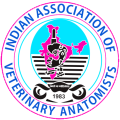HISTORY
It was 1981. Department of Zoology, University of Pune was hosting a National Symposium on Developmental Anatomy. The few stalwart figures of Veterinary Anatomy were there as the participants. The presence of like minded people brought a consensus decision to bring into being the National Body of Veterinary Anatomists. The first ad-hoc body of veterinary anatomists was formed for that upcoming Nationwide Society cum Organization. It comprised namely:
1. Dr. A. M. Shrivastava of Jabalpur (President)
2. Dr. R. V. Pandit of Nagpur (Secretary)
3. Dr. B. G. Panchmukhi of Gujrat
4. Dr. Kalyan Singh Deora of Bikaner and
5. Dr. P. A. Omar of Kerala
These five figures had imprinted the Indian Association of Veterinary Anatomists (IAVA) and the registration formalities were done by ad-hoc secretary in the Court of Society Registrar, Nagpur. It was the year 1983. The discussion which was started in the Symposium at Pune before almost 2 years for formation of society of Veterinary Anatomists came to an end at Nagpur but it brought the responsibility to nurture the IAVA to bring it into blooming. Under mentioned were the objectives of IAVA while getting registration and its the reason, sincere professional contribution remains the mandate of IAVA.
a) Promotion and advancement of Veterinary Anatomy, including all its branches such as Gross Anatomy, Histology, Cytology, Histochemistry, Developmental Anatomy, Neuroanatomy, Applied and Surgical Anatomy etc.; as it relates to all vertebrates, with special emphasis on animals of Veterinary (domestic) and wild life importance.
b) Encouragement and stimulation to research, education, extension, popularization of Veterinary Anatomy and to promote better understanding of biological structure of organisms stated under a) above.
c) Establishment of high and uniform standards of Veterinary Anatomy at proper position in educational programmes at all places of teaching and research of Veterinary and Animal Sciences in lndia. To achieve this, to recommend to all teaching, research and extension institutions, on all appropriate matters concerning Anatomy at all levels.
d) Recommend and ensure allocation of a certain percentage of posts, funds and facilities specifically for teaching and research in Veterinary Anatomy at all Universities and Colleges.
e) Encouragement to fraternity, mutual co-operation and scientific exchange amongst Veterinary Anatomists by ways of publications, symposia, seminars, workshops, exchange visits, meetings etc.
f) Protection of professional rights and interests.
The unwritten rule of efforts for survival was applicable to IAVA also. This mother organization is now firmly standing and working vibrantly after several up and downs but now it is known after its self sufficiency and the sincere professional contribution across the nation and world.
